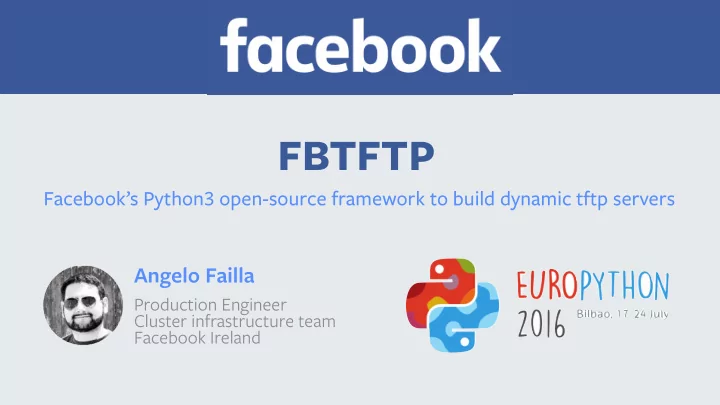

FBTFTP Facebook’s Python3 open-source framework to build dynamic tftp servers Angelo Failla Production Engineer Cluster infrastructure team Facebook Ireland
Who am I? • A Production Engineer • Similar to SRE / DevOps • Based in Facebook Ireland, Dublin • Since 2011 • Cluster Infrastructure team member • Owns data center core services • Owns E2E automation for bare metal provisioning and cluster management.
“There is no cloud, just other people’s computers…” - a (very wise) person on the interwebz “… and someone’s got to provision them.” - Angelo
POPs locations are fictional Data center locations POPs: Point of Presence
HANDS FREE PROVISIONING:
model vendor BIOS firmware OOB DHCP bootloader v6/v4 UEFI TFTP inventory sys location bootloader mysql config buildcontrol anaconda HTTP repos server type 3rd party kickstart kernel tier initrd partitioning OS schemas RPM's cyborg chef
model vendor BIOS firmware OOB DHCP bootloader v6/v4 UEFI TFTP inventory sys location bootloader mysql config buildcontrol anaconda HTTP repos server type 3rd party kickstart kernel tier initrd partitioning OS schemas RPM's cyborg chef
TFTP
It’s common in Data Center/ISP environments Simple protocol specifications Easy to implement UDP based -> produces small code footprint Fits in small boot ROMs Embedded devices and network equipment Traditionally used for netboot (with DHCPv[46])
Provisioning phases REBOOT PROVISIONED POWER ON ANACONDA NETBOOT CHEF DHCPv[46] - KEA TFTP NBP • provides network config • provides NBPs • fetches config via tftp • provides path for NBPs binaries • provides config files for NBPs • fetches kernel/initrd • provides kernel/initrd (via http or tftp)
30+ years old protocol me, ~1982 circa
Protocol in a nutshell (RRQ) X RRQ 69 DAT 1 X Y Y X ACK 1 SERVER CLIENT DAT N X Y Y X ACK N
File size Block Latency Time to Size download 80 MB 512 B 150ms 12.5 hours 80 MB 1400 B 150ms 4.5 hours 512 B/ 80 MB 1ms <1 minute 1400 B DC Latency: ~150ms POP 69 X RR X DAT Y SERVER CLIENT POPs locations are fictional X ACK Y
A look in the past ~2014 (and its problems) • Physical load balancers Servers • Waste of resources • Automation needs to know Cluster VIP which server is active HW LB • No stats • TFTP is a bad protocol in in.tftpd in.tftpd REPO (active) (passive) high latency environments • Too many moving parts Write config rsync 7GB Automation
How did we solve those problems?
We built FBTFTP… …A python3 framework to build dynamic TFTP servers • Supports only RRQ (fetch operation) • Main TFTP spec[1], Option Extension[2], Block size option[3], Timeout Interval and Transfer Size Options[4]. • Extensible: • Define your own logic • Push your own statistics (per session or global) [1] RFC1350, [2] RFC2347, [3] RFC2348, [4] RFC2349
Framework overview Monitoring Infrastructure server session callback callback get_handler() RRQ Client BaseServer BaseHandler fork() get_response_data() ResponseData transfer session child process
Example: a simple server serving files from disk
A file-like class that represents a file served: class FileResponseData(ResponseData): Monitoring Infrastructure def __init__(self, path): self._size = os.stat(path).st_size self._reader = open(path, 'rb') server session callback callback def read(self, n): return self._reader.read(n) get_handler() RRQ def size(self): BaseServer BaseHandler Client fork() return self._size get_response_data() def close(self): transfer session self._reader.close() ResponseData child process
A class that deals with a transfer session: Monitoring Infrastructure class StaticHandler(BaseHandler): def __init__(self, server_addr, peer, path, options, root, stats_callback): server session callback super().__init__( callback server_addr, peer, path, options, stats_callback) self._root = root get_handler() self._path = path RRQ BaseServer BaseHandler Client fork() def get_response_data(self): get_response_data() return FileResponseData( os.path.join(self._root, self._path)) transfer session ResponseData child process
BaseServer class ties everything together: Monitoring Infrastructure class StaticServer(BaseServer): def __init__( self, address, port, retries, timeout, server root, handler_stats_callback, session callback callback server_stats_callback ): self._root = root self._handler_stats_callback = \ get_handler() RRQ BaseServer BaseHandler Client handler_stats_callback fork() super().__init__( get_response_data() address, port, retries, timeout, server_stats_callback) transfer session ResponseData def get_handler(self, server_addr, peer, path, options): return StaticHandler( server_addr, peer, path, options, self._root, child process self._handler_stats_callback)
The “main” Monitoring Infrastructure def print_session_stats(stats): print(stats) server def print_server_stats(stats): session callback callback counters = stats.get_and_reset_all_counters() print('Server stats - every {} seconds’.format( stats.interval)) print(counters) get_handler() RRQ BaseServer BaseHandler Client fork() server = StaticServer( get_response_data() ip='', port='69', retries=3, timeout=5, root='/var/tftproot/', print_session_stats, transfer session print_server_stats) ResponseData try: server.run() child process except KeyboardInterrupt: server.close()
How do we use it? Improvements • No more physical LBs • No waste of resources Servers • Stats! requests can • TFTP servers are dynamic hit any server dynamic local • Config files (e.g. grub/ipxe Provisioning files tftp disk tftp fbtftp backends cache configs) are generated static files • Static files are streamed HTTP • You can hit any server repo • No need to rsync data • Container-friendly
Routing TFTP tra ffi c LBs are gone: which TFTP server will serve a given client? NetNorad publishes latency maps periodically, DHCP consumes it. Closest NetNorad Latency Maps DHCP TFTP server Location of TFTP Service server to Health checks discovery provision Read about NetNorad on our blog: http://tinyurl.com/hacrw7c
POPs locations are fictional POP1 local Fetches static files DC fbtftp from closest origin only for cache misses or if files changed POP2 local fbtftp
Thanks for listening! Project home: https://github.com/facebook/fbtftp/ Install and play with it: $ pip3 install fbtftp Poster session Tuesday at 14.45: Python in Production Engineering Feel free to email me at pallotron@fb.com
Recommend
More recommend